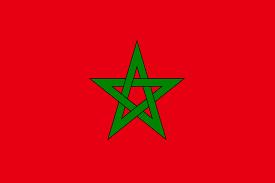Difference between revisions of "Language/Moroccan-arabic/Grammar/Negation"
m (Quick edit) |
m (Quick edit) |
||
| Line 94: | Line 94: | ||
* [https://en.wikipedia.org/wiki/Moroccan_Arabic Moroccan Arabic Wikipedia] | * [https://en.wikipedia.org/wiki/Moroccan_Arabic Moroccan Arabic Wikipedia] | ||
* [https://en.wikipedia.org/wiki/Negation Negation Wikipedia] | * [https://en.wikipedia.org/wiki/Negation Negation Wikipedia] | ||
==Related Lessons== | |||
* [[Language/Moroccan-arabic/Grammar/How-to-use-“to-be”-with-adjectives-in-Moroccan-Arabic|How to use “to be” with adjectives in Moroccan Arabic]] | |||
* [[Language/Moroccan-arabic/Grammar/Definite-Articles-in-Moroccan-Arabic|Definite Articles in Moroccan Arabic]] | |||
* [[Language/Moroccan-arabic/Grammar/Present-Continuous-in-Moroccan-Arabic|Present Continuous in Moroccan Arabic]] | |||
* [[Language/Moroccan-arabic/Grammar/Interrogative-words-in-Moroccan-Arabic|Interrogative words in Moroccan Arabic]] | |||
* [[Language/Moroccan-arabic/Grammar/Pronouns|Pronouns]] | |||
* [[Language/Moroccan-arabic/Grammar/Adjectives|Adjectives]] | |||
* [[Language/Moroccan-arabic/Grammar/The-verb-"to-Get-up"|The verb "to Get up"]] | |||
* [[Language/Moroccan-arabic/Grammar/How-to-use-“can”-in-Moroccan-Arabic|How to use “can” in Moroccan Arabic]] | |||
* [[Language/Moroccan-arabic/Grammar/How-to-use-“to-speak”-in-Moroccan-Arabic|How to use “to speak” in Moroccan Arabic]] | |||
* [[Language/Moroccan-arabic/Grammar/How-to-use-“there-to-be”-in-Moroccan-Arabic|How to use “there to be” in Moroccan Arabic]] | |||
{{Moroccan-arabic-Page-Bottom}} | {{Moroccan-arabic-Page-Bottom}} | ||
Revision as of 12:27, 6 March 2023
Hi Moroccan Arabic learners! 😊
In this lesson, you will learn how to negate sentences in Moroccan Arabic. Negation is an essential part of mastering a language, as it allows us to express negative statements and convey the opposite meaning of positive statements. We will provide examples and cultural information to help you better understand the grammar rules. Remember, practice makes perfect! Don't be afraid to make mistakes and ask for help. Let's get started!
Basic Negation
To negate a sentence in Moroccan Arabic, we use the word "ma" (ما) before the verb. "Ma" is equivalent to "not" in English. For example:
| Moroccan Arabic | Pronunciation | English |
|---|---|---|
| ما كنش ندير | ma kanš ndir | I am not doing |
Notice that in this example, we used the verb "kandir" (doing) and "ma" came before it. This is the basic structure of negation in Moroccan Arabic. Here are some more examples:
| Moroccan Arabic | Pronunciation | English |
|---|---|---|
| ما كتوجدهاش | ma ktojdhahš | He/She doesn't find it. |
| ما تزادش | ma tzedš | It didn't increase. |
| ما كتعجبنيش | ma kta’jebniš | I don't like it. |
Remember that negation affects both the present and past tenses in Moroccan Arabic. Here is an example in the past tense:
| Moroccan Arabic | Pronunciation | English |
|---|---|---|
| ما كنتش مغادي نقرا | ma kentš mghadi nqra | I wasn't going to study. |
Notice that in this example, we used the verb "mghadi" (going to) and conjugated it in the past tense "kent" (was). Again, "ma" came before the verb "mghadi" to form a negative sentence.
Here's a dialogue example to illustrate:
- Person 1: ما كنتش نلعب الكرة ديال القدم. (ma kentš nla’ab lkrat dial lqdām) (I wasn't playing soccer.)
- Person 2: ليش؟ (liš?) (Why?)
- Person 1: الطقس كان بارد جدا. (ltaqs kan barid jiddan) (The weather was too cold.)
Negating Adjectives and Adverbs
In Moroccan Arabic, we can also negate adjectives and adverbs. To do so, we add "ma" before the word. For example:
| Moroccan Arabic | Pronunciation | English |
|---|---|---|
| ما باش تاليف | ma baš talif | It's not easy. |
| ما كنحبش الزيتون | ma nħebbš zzitun | I don't like olives. |
| ما كتفهموش جيدا | ma ktfhmwš jayda | They don't understand well. |
Notice in the last example, "jayda" is an adverb, and "ma" comes before it to negate it.
Here's another dialogue example to illustrate:
- Person 1: شفت ذاك الفيلم الجديد؟ كيفاه كان؟ (šeft dāk lfīlm ljdīd? Kifāh kan?) (Did you see that new movie? How was it?)
- Person 2: ما كان حلو. (ma kan ḥlū) (It wasn't good.)
- Person 1: ليش؟ (liš?) (Why?)
- Person 2: كان ممل جدا ولا كان فيه عمل جديد ما بقاش. (kan mmal jiddan wla kan fih ‘aml jdīd ma bqaš) (It was very boring and there wasn't any new action.)
Double Negation
In Moroccan Arabic, it is possible to use double negation for emphasis. To do so, we use "ma" twice:
| Moroccan Arabic | Pronunciation | English |
|---|---|---|
| ما كنحبوش جديدا | ma nħebbwš jdidan | I don't really like it (lit. I don't not like it) |
| ما شفتش حد هنا | ma šeftš hd hna | I haven't seen anyone here (lit. I don't see no one here) |
Here's another dialogue example to illustrate:
- Person 1: شنو رايك في هاد المسلسل الجديد؟ (šnū rāyik fī hād almslsal ljdid?) (What do you think about this new TV show?)
- Person 2: ما كنحبوش جيدا جدا. (ma nħebbwš jayda jiddan) (I don't really like it.)
- Person 1: ليش؟ (liš?) (Why?)
- Person 2: القصة كانت ماشي مثيرة والأداء كان بعضو كيملل. (lqşa kanet māši mṯyra wal’dda’a kan b’ḍuh kaymll.) (The plot wasn't exciting and the acting was inconsistent.)
Conclusion
Negation is a crucial aspect of Moroccan Arabic grammar, as it allows us to convey negative statements and express the opposite meaning of positive statements. Remember that to form a negative sentence, we use "ma" before the verb, adjective, or adverb. Practice with the examples we've provided and create your own sentences. To improve your Moroccan Arabic Grammar, you can also use the Polyglot Club website. Find native speakers and ask them any questions!
➡ If you have any questions, please ask them in the comments section below.
➡ Feel free to edit this wiki page if you think it can be improved. 😎
Sources
Related Lessons
- How to use “to be” with adjectives in Moroccan Arabic
- Definite Articles in Moroccan Arabic
- Present Continuous in Moroccan Arabic
- Interrogative words in Moroccan Arabic
- Pronouns
- Adjectives
- The verb "to Get up"
- How to use “can” in Moroccan Arabic
- How to use “to speak” in Moroccan Arabic
- How to use “there to be” in Moroccan Arabic
